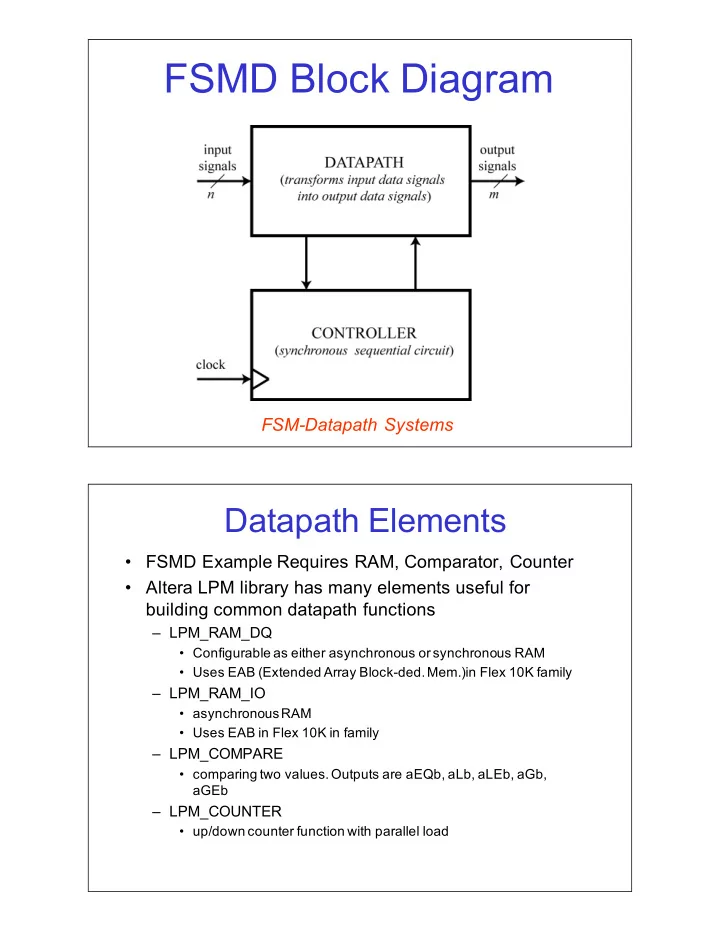

FSMD%Block%Diagram FSM$Datapath*Systems Datapath%Elements • FSMD%Example%Requires%RAM,%Comparator,%Counter • Altera%LPM%library%has%many%elements%useful%for% building%common%datapath%functions – LPM_RAM_DQ%% • Configurable%as%either%asynchronous%or%synchronous%RAM • Uses%EAB%(Extended%Array%BlockJded.%Mem.)in%Flex%10K%family – LPM_RAM_IO% • asynchronous%RAM%% • Uses%EAB%in%Flex%10K%in%family – LPM_COMPARE • comparing%two%values.%Outputs%are%aEQb,%aLb,%aLEb,%aGb,% aGEb – LPM_COUNTER • up/down%counter%function%with%parallel%load
Controllers%in%FSMDs • The%job%of%the%finite%state%machine%is%to%sequence% operations%on%a%datapath R E R DOUT G DIN X + E G R E G FSM Control (reg load lines, mux selects) Synchronous%vs%Asynchronous%RAM • Asynchronous%RAM – combinational%element,%No%Clock%input – No%Clock – Data%available%after%propagation%delay%from%address – Address%MUST%BE%stable%while%WE%(write%enable)%is% high%so%that%only%ONE%location%is%written%too.%%Data%must% also%be%stable%during%write%cycle. • Synchronous%RAM – sequential%element,%Clock%input%present – latches%input%data%and%control%lines%(address,%data)
Counters%for%Driving%Address%Lines WE%and%addr%can%Change%Close%in%Time Delays%can%cause%WE%to%change%before%or%after%address.%%If% before,%then%can%write%to%both%LocA%and%LocB
Sync%RAM%latches%address%and%WE WE,%addr%latched%here Write%occurs%here Use%Synchronous%RAM%when%Possible • Often%when%using%Asynchronous%RAM%generally% end%up%latching%the%address,%WE,%and%din%anyway • Use%Synchronous%RAM%if%available%and%possible% for%Application • In%Lab%exercises%and%Class%Examples,%will%always% use/assume%synchronous%RAM – Will%not%latch%output%data%unless%specifically%needed – Options%to%latch%control,%input%data,%output%data%available% on%LPM_RAM_DQ
Asynchronous%vs%Synchronous%Control • Many%LPMS%have%both%synchronous%and% asynchronous%control%lines – LPM_COUNTER%has%‘aload’%(asynchronous%load),%and% ‘sload’%(synchronous%load)\%%‘aclr’%and%‘sclr’%(async%and% sync%clear) • Always%use%a%Synchronous%control%line%if%possible,% especially%if%connected%to%a%FSM%output. – Any%glitch%on%an%asynchronous%control%line%can%trigger%it – If%using%a%FSM%output%for%an%asynchronous%control,%the% output%should%come%directly%from%a%FlipJFlop%output,%NOT% from%combinational%gating. Sample%FSMD%Design • Create%a%synchronous%RAM%block%that% has%a%‘zeroing’%capability • If%external%‘zero’%input%asserted,%assert% BUSY%output%and%zero%RAM%block • Load%a%LOW%and%HIGH%address%that% specifies%the%memory%words%to%reset • Assume%RAM%size%is%64%x%8
Memory%Zeroing%FSMD RAM*&*External*Datapath Components FSMD%Design%Steps 1) Define/Specify%Input/Output%Signals 2) Design%the%Datapath%Diagram 3) Define/Specify%Control%Signals 4) Design%the%Controller%ASM%Chart 5) Realize%Controller%in%HDL 6) Realize%Datapath%in%HDL%and/or%Schematic% Capture 7) Interconnect%Datapath%&%Controller 8) Validate%Design/Perform%Timing%Analysis
FSMD%Input/Output%Signals • Inputs ! clk, reset ! low_ld J load%LOW%value%obtained%from%address%bus ! high_ld J load%HIGH%value%obtained%from%address%bus ! din[7..0] J data%bus%input%to%RAM ! addr[5..0] J address%bus%input%to%RAM%% ! zero J initiate%a%zero%cycle • Outputs ! dout[7..0] J memory%output%during%“normal”%operation ! busy J output%indicating%zeroing%operation%is%occurring Datapath%Elements%%Needed • Two%registers%to%hold%LOW,%HIGH%value – Use%LPM_DFF%or%write%Verilog%model%( reg6.v ) • Need%a%6Jbit%counter%to%cycle%address%lines%of% RAM – LPM_COUNTER – Counter%needs%to%be%loaded%with%LOW%value%when%we% start%to%zero%the%RAM • Need%a%Comparator%to%compare%Counter%value% and%HIGH%value%to%see%if%we%are%finished • Need%the%RAM%(use%LPM_RAM_DQ) • Multiplexers%(LPM_MUX%or%HDL)
Datapath%Block%Diagram Control*lines*are*not*shown*on*datapath*diagrams!!! Required%FSM%Control%Signals (examine%each%Datapath%component) Registers:%Load%lines%for%LOW,%HIGH%registers%driven% externally%and%NOT%under%FSM%control. Counter:%%%sload%(synchronous%load),%cnt_en%(count% enable).%Counter%will%be%configured%to%only%count%up. Mux%Selects:%%When%doing%‘zero’%operation,%counter% will%be%driving%RAM%address%lines%and%RAM%input%data% line%will%be%zero.%The%same%select%line%can%drive%both% multiplexers. RAM:%%The%WE%of%the%RAM%needs%to%be%an%OR%of%the% external%WE%and%a%WE%that%is%provided%by%the%FSM.
Control%Signals Required%Controller%Operations 1) Wait%for%external% zero command% (controller%waits%for%‘ zero ’%input%to%be% asserted)%– RAM%in%“normal”%mode 2) Load%the%counter%with%the%LOW%address% value 3) Write%‘0’%data%value%to%RAM%via%address% specified%by%counter,%incrementing% counter%each%clock%cycle.%%Stop%writing% when%HIGH%register%value%equals% counter%value. Three*DISTINCT*operationsA*need*3*control*STATES
ASM%State%Definitions • Three%States • State% S0 waits%for% zero operation.%In%this%state%the% external% addr and% din busses%are%multiplexed%to% RAM.%%Set%busy%flag%on%transition%to%State% S1 . • State% S1 loads%counter%with%LOW%register%value • State% S2 does%zero%operation.%%Exit%this%state%with% counter%value%equals%to%HIGH%register%value.%%On% state%exit,%clear%the%busy%flag%output%(conditional% output).%% – Controller%requires%HIGHJLOW+1%clocks%in%this%state% (clear%LOW%to%HIGH%locations%inclusive) Memory%Zeroing%ASM%Chart
Memory%Zeroing%FSMD%Diagram Design%Implementation • DESIGN%TASK: – Specify/define%Input/Output%(often%this%is%in%prior% “spec”%phase) – Design%Datapath%(draw%datapath%diagram) – Specify%Controller%and%Datapath%Interface – Design%Controller%(draw%ASM%chart) • IMPLEMENTATION: – Realize%Datapath%in%HDL%or%Schematic – Realize%Controller%(HDL%only%in%this%class) – Interface%Datapath%and%Controller%to%produce%FSMD Datapath$first*approach*is*my*preference*$ can*often*find*logic flaws*through*careful*consideration*of*datapath*before*worrying about*the*controller
Design%Implementation%Guidelines • Perform%some%Intermediate%Validation%on%Datapath – Datapath%Component%Hierarchy%can%be%Helpful • After%Datapath%is%finished,%Implement%Controller%in%HDL – Initially%Specify%FSM%State%Value%as%External%Output%for%Debugging – Generate%Controller%HDL%directly%from%ASM%chart – Some%Intermediate%Validation%of%Controller • FSMD%Validate/Debug%J take%a%systematic%approach – FSMD%will%USUALLY%NOT%WORK%the%first%time%J be%prepared%to% debug. – Attach%external%pins%to%as%many%internal%nets%as%possible%or%use%the% “logic%probe”%capability%to%observe%the%internal%net%values – Debug%FSMD%ONE%state%at%a%time%beginning%with%RESET%state.% – Do%not%test%the%next%state%until%the%current%state%works%as%expected. Design%Implementation%Guidelines • Based%on%your%confidence%with%HDL,%decide%to%use% LPM%components%versus%HDL%Specification%in% Datapath • Always%use%a%VERY%LONG%clock%cycle%to%start%out% with%so%that%you%do%not%encounter%timing%problems – Can%also%use%Functional%Simulation – To%be%absolutely%safe,%make%external%inputs%change%on% the%falling%edge%if%your%internal%logic%is%rising%edge% triggered%(this%gives%you%1/2%clock%of%setup%time).
DATAPATH% COMPONENT% SPECIFICATION% USING%AN%HDL Data%(D)%Latch //HDL Example 5-1 //-------------------------------------- //Description of D latch (See Fig.5-6) module D_latch (Q,D,control); output Q; input D,control; reg Q; always @ (control or D) if (control) Q = D; //Same as: if (control == 1’b1) Q = D; endmodule No%default% D Q assignment%for% ‘ Q ’\%only% control assigned%when% gate%is%high.
D FLIPJFLOP D Q //HDL Example 5-2 (adaptated-MAT) //----------------------- //D flip-flop CLK module D_FF (Q,D,CLK); output Q; input D,CLK; Rising%edge reg Q; always @ (posedge CLK) Q <= D; Assignment% endmodule ‘protected’%by% clock%edge.%So% DFF%is% DFF*with*Single* synthesized. Synchronous*Input Another*D FLIPJFLOP //D flip-flop with asynchronous reset. D Q //(adapted-MAT) module DFF (Q,D,CLK,RST); CLK output Q; RST input D,CLK,RST; reg Q; always @(posedge CLK or negedge RST) if (~RST) Q <= 1'b0; // Same as: if (RST == 1'b0) else Q <= D; endmodule DFF*with*Single* Assignment% Synchronous*Input after%rising%edge% and*Asynchronous clock%so%DFF%is% reset*(RST) synthesized.
JK and% T FLIPJFLOPS //JK flip-flop from //T flip-flop from D // D flip-flop and gates // flip-flop and gates module JKFF (Q,J,K,CLK,RST); module TFF (Q,T,CLK,RST); output Q; output Q; input J,K,CLK,RST; input T,CLK,RST; wire JK; wire DT; assign JK = (J & ~Q) assign DT = Q ^ T ; | (~K & Q); //Instantiate the D flip- //Instantiate D flipflop flop DFF JK1 (Q,JK,CLK,RST); DFF TF1 (Q,DT,CLK,RST); endmodule endmodule JK FLIPJFLOP //HDL Example 5-4 (adapted-MAT) //---------------------------------- // Functional description of JK flip-flop module JK_FF (J,K,CLK,Q,Qnot); output Q,Qnot; input J,K,CLK; reg Q; assign Qnot = ~ Q ; always @ (posedge CLK) case ({J,K}) 2'b00: Q <= Q; 2'b01: Q <= 1'b0; 2'b10: Q <= 1'b1; 2'b11: Q <= ~ Q; endcase endmodule Description*Based*on*Characteristic*Table*Directly
Recommend
More recommend